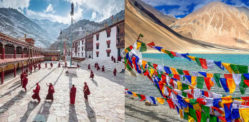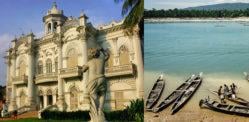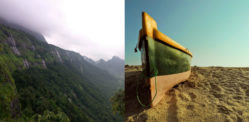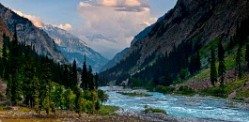But in 1849 the mosque was restored by the British
Embarking on a journey to explore the breathtaking landscapes, rich cultural heritage and historical marvels of Pakistan is an endeavour that promises an unforgettable experience.
From the lush Hunza Valley to the bustling streets of Lahore steeped in Mughal grandeur, Pakistan offers a treasure trove of destinations waiting to be discovered.
Each place offers its own unique charm and historical significance.
Whether you’re a history buff, an adventure seeker, or simply in search of serene landscapes, Pakistan’s diverse attractions are sure to captivate and inspire.
Here are 10 places to visit when in Pakistan.
Badshahi Mosque
Also known as the Emperor’s Mosque, Badshahi Mosque was made using sandstone and marble in the 17th century in Lahore.
In 1799, Maharaja Ranjit Singh’s Sikh Empire seized control of Lahore. He converted the mosque into a horse stable and an ammunition depot.
But in 1849 the mosque was restored by the British who initially used the mosque for military purposes.
It has stunning architecture and also represents the city’s politics.
The Badshahi Mosque consists of a formal prayer hall, a courtyard, a 22-step red sandstone stairway and floral bouquets with tulips and cypress trees.
The interior has calligraphy, stucco tracery (manbatkari), which is ornamental work and beautiful works on the ceiling.
Its prayer hall has a variety of white marble geometric patterns and floral motifs. In addition, there are copper-gold ornaments with gilded bulbs.
The mosque has three main domes, with the central dome standing over 68 metres.
Above the prayer hall is a dome on the left and a dome on the right.
Hunza Valley
Snow-capped peaks, lavish green meadows and stunning rivers surround Hunza Valley.
It attracts trekkers and nature enthusiasts alike.
The valley is renowned for its blossoms in the spring, vibrant landscape and the Baltit Fort which signifies the region’s history.
It surrounds the Hunza River and the length of a trek varies from a few hours to several days.
The Baltit Fort is a steep walk and the tour guide shows people around the village.
In Spring, there is a calming atmosphere and it is the best time to visit this part of Pakistan.
As you are taken on the somewhat challenging mountainous treks, you can visit the Baltoro Glacier and the K2 Base camp.
Part of the trek provides an insight into the lifestyles of the Hunza people.
The Hunza people lead active lives and their diet is profound in fruits, vegetables and grains. This contributes to their long lifespans.
They have a stress-free environment, immersed in mountain air and glacier water. There is also a strong sense of community in this area of Pakistan.
Lahore Fort
The Lahore Fort, also known as Shahi Qila, is a complex of marble mosques, palaces and fortifications.
It contains 21 notable monuments, some of which date to the era of Mughal ruler Akbar the Great.
Since his reign, successive leaders have made their mark on the fort, including Shah Jahan.
Jahan was influenced by the beauty of the Lahore Fort which inspired his Sheesh Mahal.
It has ornate and lovely sites such as the Naulakha Pavillion. This was built in 1665 and is one of the 20 structures in the Fort.
It has a unique rectangular pavilion with a special arched roof and was once the Emperor’s summer house.
The name came about as it describes a priceless object.
The entrance to the fort is the Alamgiri Gate built by Aurangzeb in 1674 as a private entrance to the royal quarters.
It was large enough to allow several elephants carrying members of the royal family to enter.
Another feature is the Moti Masjid, also known as the Pearl Mosque, which was completed in 1663.
Deosai National Park
This park is the second-largest alpine plateau in the world, spanning over 3,000 square kilometres.
Deosai National Park is located in the Northern Areas of Pakistan, specifically in the Gilgit-Baltistan region. It spans parts of Skardu, Astore and Gultari valleys.
It was officially established as a protected area in 1993 to safeguard its natural resources and promote sustainable tourism.
From Skardu, which is northwest of the park, one can trek through the Burji La Pass to Deosai.
After a couple of days of trekking with a guide, and camping between, this leads to the lovely Sheosar Lake.
In spring, beautiful wildflowers bloom all over the green grassland. The waters are crystal clear, the mountains are spectacular.
Before reaching Deosai, one can witness the views of Nanga Parbat, which is the ninth-highest peak in the world.
On the tour, Sheosar Lake is the first stop. Then at Bara Pani, one can spend the day bear-watching.
As one journeys back to Skardu, they can enjoy a drive along the River Indus.
Pakistan Monument Museum
This Pakistan Monument Museum is located in Islamabad.
It represents Pakistan’s history and cultural heritage, commemorating the martyrs who sacrificed their lives for their country.
The structure is in two sections.
At one end there is a symbolic giant memorial shaped like the petals of a flower that represents the creation of the nation.
The four petals celebrate four provinces – Punjab, Sindh, Balochistan and Khyber Pakhtunkhwa.
The three smaller petals represent Jammu and Kashmir, Gilgit-Baltistan and the Federally Administered Tribal Areas.
On the other end, there is a wax museum.
The murals represent Pakistan’s independence, as well as celebrating landmarks across the country.
Inspired by ex-President Pervez Musharraf, it was designed to be a national monument.
It signifies a sovereign state and the strength of the people in the land.
Kachura Lakes
The Kachura Lakes are a pair of lakes located in the Skardu District of Gilgit-Baltistan.
They are often collectively referred to as the “Upper” and “Lower” Kachura Lakes due to their relative elevations.
Upper Kachura Lake is the smaller lake but the more famous.
It is surrounded by rocky mountains and has crystal-clear blue water that reflects the surrounding peaks, creating a stunning mirror-like effect.
Visitors can enjoy boating in the lake and admire the breathtaking scenery.
Lower Kachura Lake is also known as Shangrila Lake. It is named after the Shangrila Resort, a popular tourist destination situated nearby.
The resort offers accommodations and recreational activities for visitors to enjoy the serene beauty of the lake and its surroundings.
Both lakes are fed by glacial meltwater from the nearby mountains, contributing to their pristine and refreshing waters.
Hawkes Bay
Hawkes Bay is a beach in the Sindh province of Pakistan and is located 20 kilometres southwest of Karachi.
It is believed to have been named after a British officer, Captain Hawkes, who served during the British colonial period in the Indian subcontinent.
Captain Hawkes was associated with the development and administration of the Karachi region
Tourists visit Hawkes Bay to sunbathe, swim and have beachside picnics.
Hawkes Bay is known for its relatively clean and serene environment compared to some other beaches in the region.
The combination of the sea, sand, and rocky formations makes it a picturesque destination for beachgoers and nature lovers.
Shalimar Gardens
Shalimar Gardens is situated in the eastern part of Lahore, near the Baghbanpura neighbourhood. It is easily accessible from various parts of the city and is a popular tourist attraction.
The garden was built during the reign of Emperor Shah Jahan.
It was completed in 1641 and served as a royal retreat and pleasure garden for the Mughal emperors and their court.
Shalimar Gardens is characterised by terraced levels, symmetrical layouts, water features and lush plants.
One of the highlights of Shalimar Gardens is the stunning marble pavilions, known as “baradaris”, situated at the central axis of each terrace.
In recognition of its historical and cultural significance, Shalimar Gardens, along with other Mughal-era sites in Lahore, was designated as a UNESCO World Heritage Site in 1981.
Tomb of Jahangir
Jahangir’s Tomb is situated in Shahdara Bagh, a suburb of Lahore along the northern bank of the Ravi River.
The tomb was built to house the remains of Emperor Jahangir.
Construction of the mausoleum took 10 years.
Jahangir’s Tomb is a significant example of Mughal architecture, blending elements of Islamic, Persian and Indian design.
The mausoleum features a square plan with a central dome and four minarets at each corner.
Its exterior is adorned with intricate tile work, marble inlay and calligraphy, showcasing the craftsmanship of Mughal artisans.
Jahangir’s Tomb is surrounded by charbagh-style gardens, which are divided into four quadrants by water channels and pathways.
The gardens are laid out in a symmetrical pattern and were designed to provide a serene and harmonious setting for the mausoleum.
The interior has a central chamber where Emperor Jahangir’s cenotaph is placed.
The walls and ceilings are embellished with floral motifs, Quranic inscriptions, and geometric patterns inlaid with precious stones and colourful tiles.
It is also recognised as a UNESCO World Heritage Site for its architectural and artistic value.
Mohenjo-Daro
Mohenjo-Daro is one of the most important archaeological sites related to the ancient Indus Valley Civilisation, dating back to around 2,500 BCE.
It is situated in the Larkana District of Sindh, lying along the banks of the Indus River.
The city of Mohenjo-Daro was carefully planned and organised, featuring a grid-like layout with straight streets and well-defined residential and public areas.
The buildings in Mohenjo-Daro were constructed using mud bricks and many structures had multiple stories.
Excavations at Mohenjo-Daro have revealed a wealth of artefacts, including pottery, tools, seals, jewellery and sculptures.
The famous “Priest-King” statue, depicting a male figure in ceremonial attire, is one of the notable artworks found at the site.
However, Mohenjo-Daro declined and was eventually abandoned, with the exact reasons still debated among archaeologists.
Factors such as environmental changes, flooding of the Indus River and socio-political shifts have been suggested as possible causes.
Pakistan offers a diverse range of top-notch destinations that cater to both the explorer’s spirit and the quest for knowledge.
From delving into the opulent world of the Mughals to experiencing the unique culture of modern-day societies, Pakistan offers a rich variety of experiences waiting to be unravelled.
Travelling through Pakistan is not merely about sightseeing; it’s an educational journey that allows us to gain insights into different eras and lifestyles.
Enriching oneself through travel means embracing the beauty and diversity that these top places in Pakistan have to offer.
So pack your bags, embark on an adventure, and uncover the treasures that await in these ten top places to visit in Pakistan.







































































